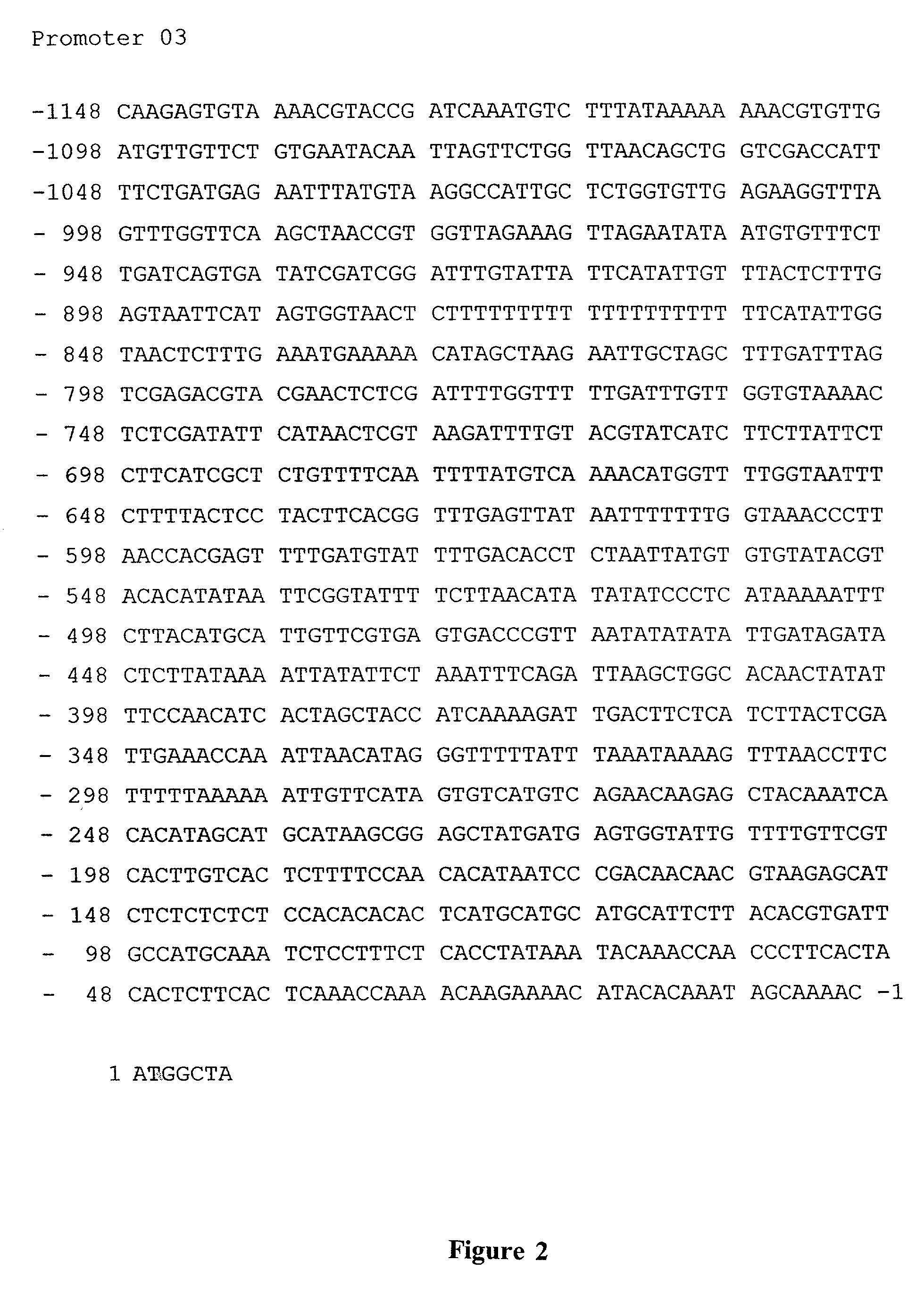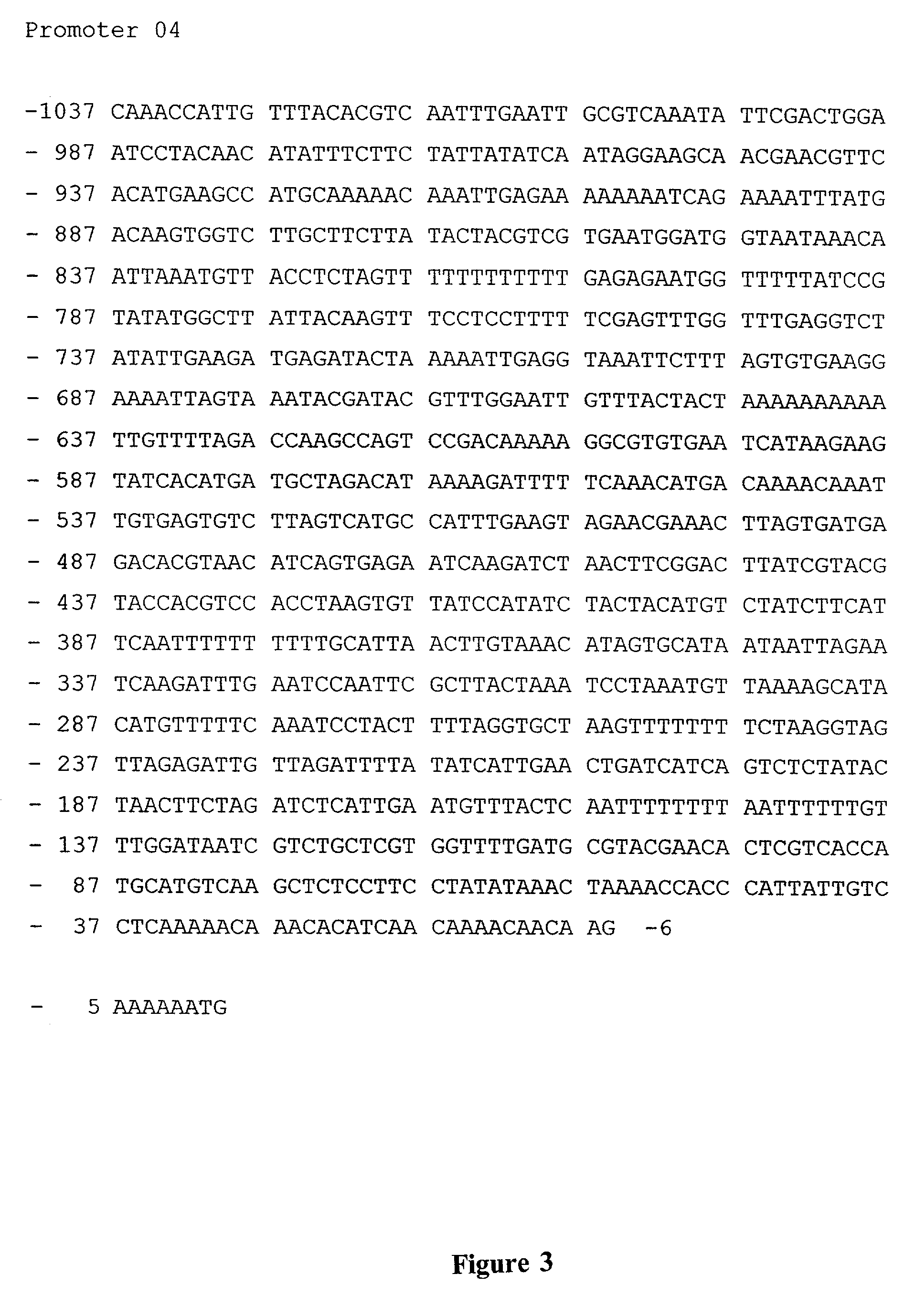Plant seed specific promoters
- Summary
- Abstract
- Description
- Claims
- Application Information
AI Technical Summary
Benefits of technology
Problems solved by technology
Method used
Image
Examples
example 2
[0274] Microarray Analysis of ESTs from Developing Seeds
[0275] A. Amplification of cDNAs
[0276] The plasmids of 2715 selected cDNA clones were collected from data set I. The inserts of the cDNAs were amplified by PCR in a 96-well format using primer pairs specific for the vector ends (for inserts in pBluescript SK-: T7, 5'-GTAATACGACTCACTATAGGGC, and 5' extended M13 reverse, 5'-ACAGGAAACAGCTATGACCATG; for inserts in pZipLox1: M13 forward, 5'CCCAGTCACGACGTTGTAAAACG and M13 reverse, 5'-AGCGGATAACAATTTCACACAGG). PCR reactions of 100 .mu.L volume contained 0.4 .mu.M of each primer, 0.2 .mu.M of each desoxynucleotide, 10 mM Tris, 50 mM KCl, 3.0 mM MgCl.sub.2, 3 U Taq DNA polymerase (Promega, Madison) and .about.10 ng plasmid template. The reactions were run on a Perkin Elmer 9700 Thermoblock using an amplification program of 3 min denaturation at 94.degree. C., 5 precycles of 30 s at 94.degree. C., 30 s at 64.degree. C., 2 min at 72.degree. C., followed by 30 cycles of 30 s at 94.degree. ...
example 3
[0289] Identification, Isolation and Characterization of Seed-Specific Promoter Regions
[0290] A. Materials
[0291] Genomic DNA which was used for PCR amplification was extracted from Arabidopsis leaves using the CTAB method (for example, as described by Stewart et al., Biotechniques: 14(5):748-50 (1993).
[0292] B. Data and Sequences Analysis
[0293] Individual EST sequences were compared using BLAST against Arabidopsis genomic sequences larger than 10 Kb using the TAIR server manually (www.arabidopsis.org / blast / ). After the positions of these EST sequences in the genome were determined, approximately 20 Kb flanking sequences of 30 genes were analyzed by Gene Identification Programs such as GenScan, GeneFinder and NetStart to determine the positions of ATG translation starts. The promoter regions were defined as those regions approximately 1 Kb upstream of ATG; these regions were then selected for PCR amplification.
[0294] C. Molecular Cloning and Vector Construction
[0295] To construct a G...
PUM
| Property | Measurement | Unit |
|---|---|---|
| Time | aaaaa | aaaaa |
| Fraction | aaaaa | aaaaa |
| Electrical conductance | aaaaa | aaaaa |
Abstract
Description
Claims
Application Information
 Login to View More
Login to View More - R&D
- Intellectual Property
- Life Sciences
- Materials
- Tech Scout
- Unparalleled Data Quality
- Higher Quality Content
- 60% Fewer Hallucinations
Browse by: Latest US Patents, China's latest patents, Technical Efficacy Thesaurus, Application Domain, Technology Topic, Popular Technical Reports.
© 2025 PatSnap. All rights reserved.Legal|Privacy policy|Modern Slavery Act Transparency Statement|Sitemap|About US| Contact US: help@patsnap.com



